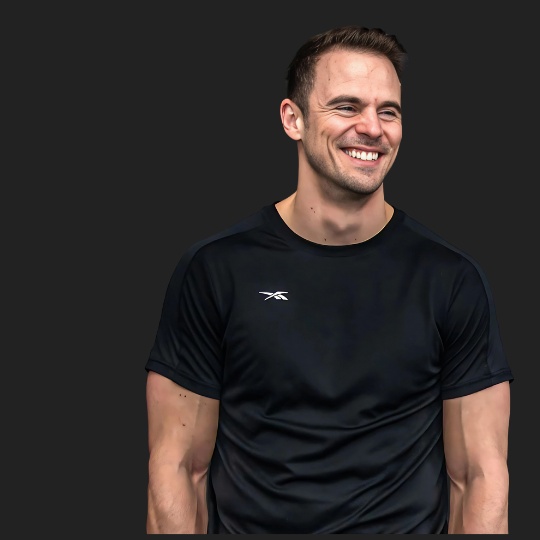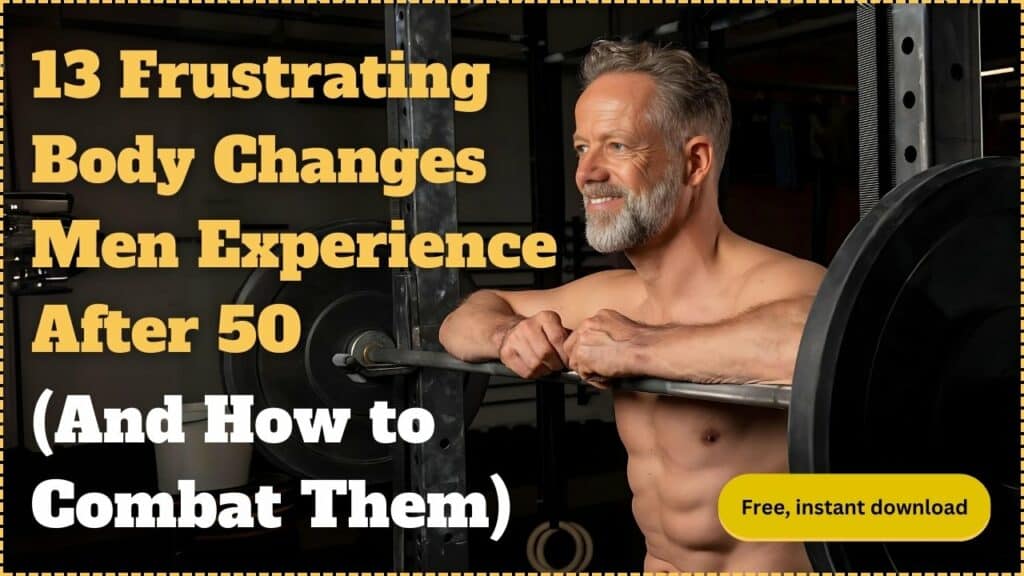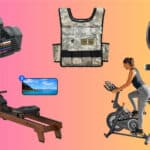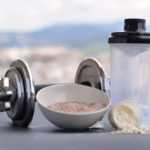The shoulders are a hallmark of strength, athleticism, and commitment to physical performance. But how do you develop boulder shoulders reminiscent of Arnold himself?
Building big shoulders requires the proper movement and techniques. We cover the 15 best shoulder exercises so you can grow amazing and functional shoulders.
Read on for everything you need to know.
Jump to:
Deltoid Muscle Anatomy
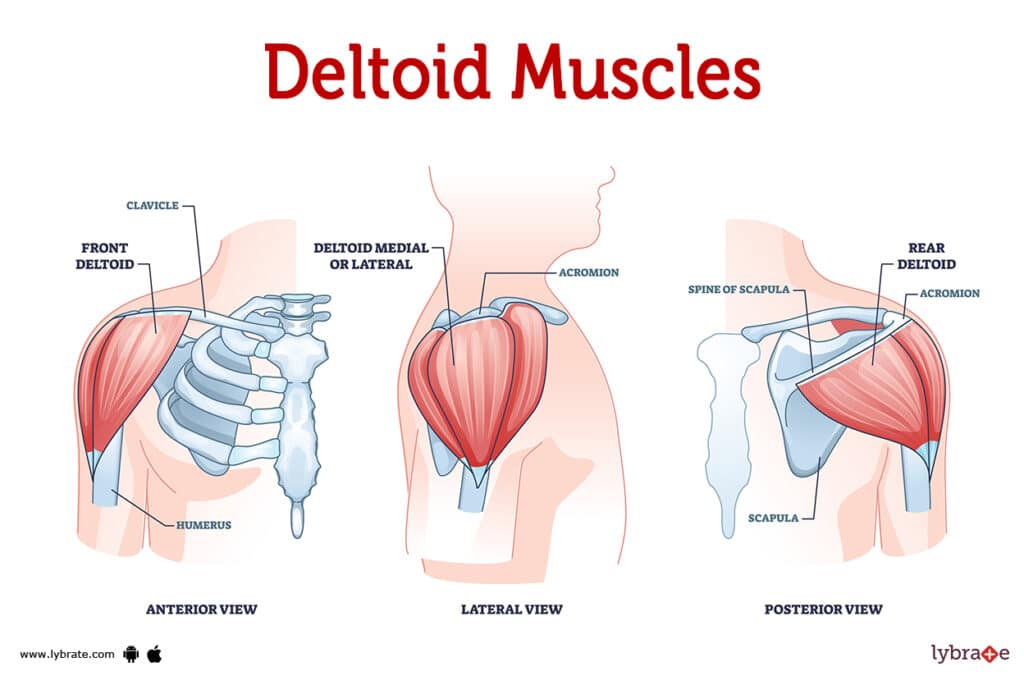
Strong shoulders don’t just require time in the gym or protein—you need to understand shoulder muscle anatomy to get the best results. The shoulder is a complex joint that plays a crucial role in day-to-day life and is made up of three main delt heads:
- The front (anterior) deltoid
- The lateral (side or middle) deltoid
- The posterior (rear or back) deltoid
The different delt heads start in different shoulder areas, connecting to create a single tension that attaches to the upper arm. Each muscle head helps with different activities, like raising the arm up and down or throwing objects.
But if you’re curious why your arm doesn’t slide off the shoulder socket, you can thank the rotator cuff. The rotator cuff muscles and tendons surround the shoulder joint, providing the shoulder joint with stability and strength.
Front Deltoid Exercises
The front, or anterior deltoid, sits on the front of your shoulder. You use it for flexion and internal rotation of the arm. Raising something in front of the body, throwing an object, and pressing items overhead involve the front delts.
There is a wide range of exercises that engage the front delts, many of which recruit several muscles like the upper back. Here are some of the best options to consider when creating your complete shoulder regimen.
1. Barbell Overhead Press
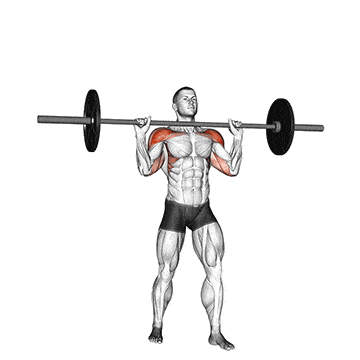
Technically, the Barbell Overhead Press targets all three deltoid heads. It is a compound movement, primarily engaging the front and middle delts. The rear delts aren’t emphasized as much, and the triceps are used as supporting muscles.
The overhead exercise is straightforward—pick up a barbell and lift it over your head. Despite being straightforward, this is a fundamental exercise for building shoulder strength, size, and range of motion.
- Stand with feet roughly shoulder distance apart.
- Hold a barbell at shoulder height, palms facing forward.
- Press the barbell overhead until the arms are completely straightened.
- Lower the barbell once again to the original stance to finish one repetition. Repeat for your desired rep range.
2. Seated Dumbbell Overhead Press
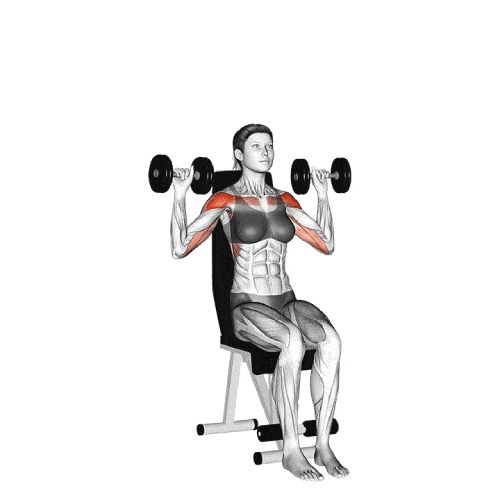
You might ask, “Why perform the seated dumbbell variation if I can do the standing barbell overhead press?”
The Seated Dumbbell Overhead Press has a few distinct advantages compared to other overhead shoulder workouts. First, it is a unilateral movement, meaning it trains one arm at a time. This helps with muscle imbalances, technique issues, and shoulder stability.
Second, the seated variation doesn’t require the abdominal muscles as much. This makes the movement a great shoulder isolation exercise. Overall, it’s wise to incorporate this move into your shoulder training regimen for strength, size, and stability gains.
- Sit on an exercise bench with back support.
- Hold dumbbells around shoulder height, palms facing forward.
- Push the dumbbells overhead until your arms are straight.
- Lower dumbbells to the original stance and repeat.
3. Push Press
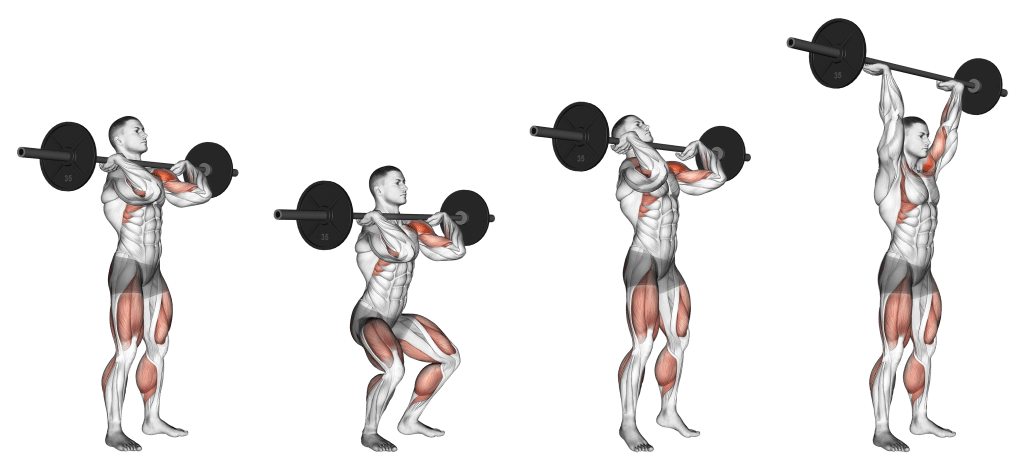
To develop strong shoulders, you must incorporate the Push Press into your routine. The Push Press is similar to other overhead workouts but involves a slight leg drive, allowing you to lift heavier weights and activate the front deltoids more effectively.
Not only will this help you build shoulder size and strength, but it will also enhance your overall upper-body explosiveness. Performing this exercise will engage the front deltoids, contributing to a well-proportioned and robust shoulder appearance.
- Begin with a barbell on your shoulders, palms facing forward.
- Slightly bend your knees, then explosively extend them to help push the bar overhead.
- Finish with arms extended and locked out.
- Lower the barbell back to your shoulders and repeat.
4. Front Deltoid Raise
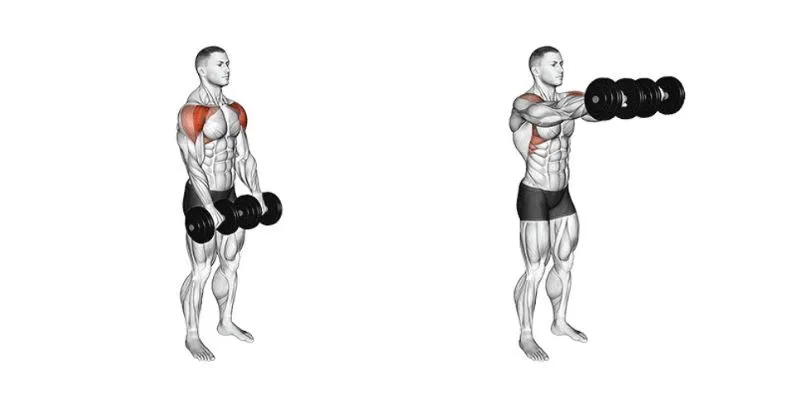
The Frontal Raise is a bodybuilding staple for hypertrophy training. This exercise is commonly performed with a pair of dumbbells, but you can use a cable machine, resistance bands, kettlebells, or other free weights.
Frontal raises are another unilateral exercise, helping you push each shoulder to its maximum limit. You can utilize light weights in high rep ranges to really push the shoulder muscles to failure. It will add volume to your deltoid training regimen, helping you build more size, definition, and endurance.
- Stand with dumbbells in front of your thighs, palms facing your body.
- Lift dumbbells forward until they reach shoulder level.
- Lower the dumbbells back down slowly and repeat.
5. Incline Bench Press
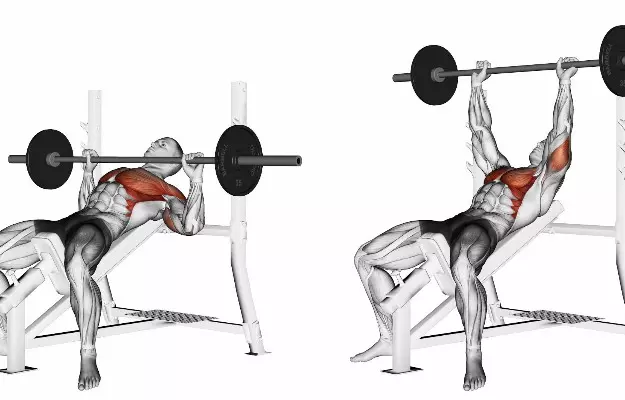
The Incline Bench Press is a foundational movement in strength and hypertrophy training, targeting the upper chest and anterior deltoids. This exercise is traditionally performed with a barbell on an incline bench, but can also be executed using dumbbells, a Smith machine, or even resistance bands for a varied stimulus.
The incline angle specifically emphasizes the upper pectoral muscles, offering a unique challenge compared to the flat bench press. It’s an excellent exercise for achieving a balanced and sculpted chest, enhancing both strength and muscle definition. By adjusting the incline, you can also slightly shift the focus between the upper chest and shoulders, allowing for comprehensive upper body development.
To perform the Incline Bench Press:
- Set the bench to a 30 to 45-degree incline.
- Lie back with your feet flat on the floor, gripping the barbell slightly wider than shoulder-width.
- Lower the bar to your upper chest, keeping your elbows at a 45-degree angle to your body.
- Press the bar back up to the starting position, focusing on using your chest muscles.
Middle Deltoid Exercises
The middle or lateral deltoids are found on the sides of the shoulders, contributing to upper body width and size. They help with shoulder abduction—when you raise your arm up or down. Activities like carrying in groceries or lateral raises are common activities requiring side delts.
Engaging the muscle group is a must if you want more muscular, more robust shoulders. Here are a few of our favorite exercises to keep in mind.
1. Lateral Raises
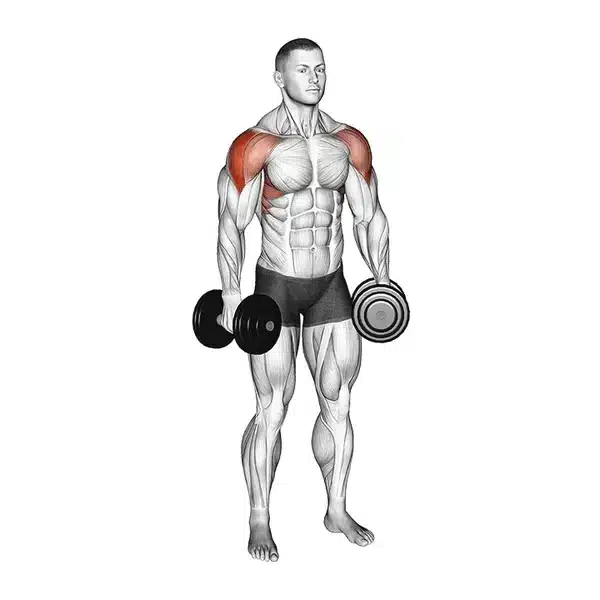
Isolation exercises like the Lateral Raise are ideal for building middle delts. The lateral delts contribute to upper body width and size, helping you achieve a more imposing physique. Like other unilateral exercises, the lateral raise can help address strength discrepancies across your shoulders.
It’s better to use lighter weights, as heavyweights can strain the medial delts and cause a potential shoulder injury. As far as lateral delt exercises go, this is a must-have in your shoulder workout routine.
- Stand with dumbbells at your sides, palms facing your body.
- Lift dumbbells out to the sides until they reach shoulder height.
- Lower the dumbbells back down slowly and repeat.
2. Leaning Cable Lateral Raise
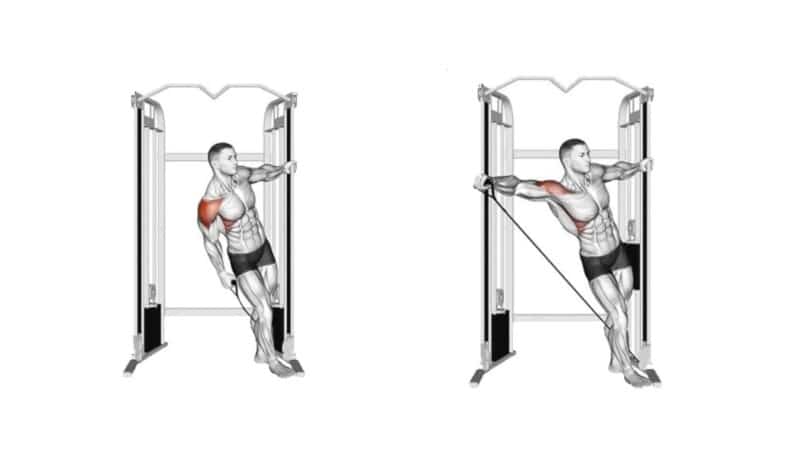
The Leaning Cable Lateral Raise is one of the most effective movements for engaging the middle delts. The leaning position increases the range of motion, while the cable machine provides constant tension in the lateral deltoid.
More time under tension equals more potential upper-body muscle mass gains. You can pause at the height of the movement to make the exercise even more challenging, thus increasing the possible gains even further.
- Attach a D-handle to a low pulley cable.
- Stand sideways to the cable machine, and hold the handle in the hand farthest from the machine.
- Lean slightly away and lift the handle to the side, targeting lateral deltoids.
- Lower the handle back and repeat.
3. Upright Barbell Row
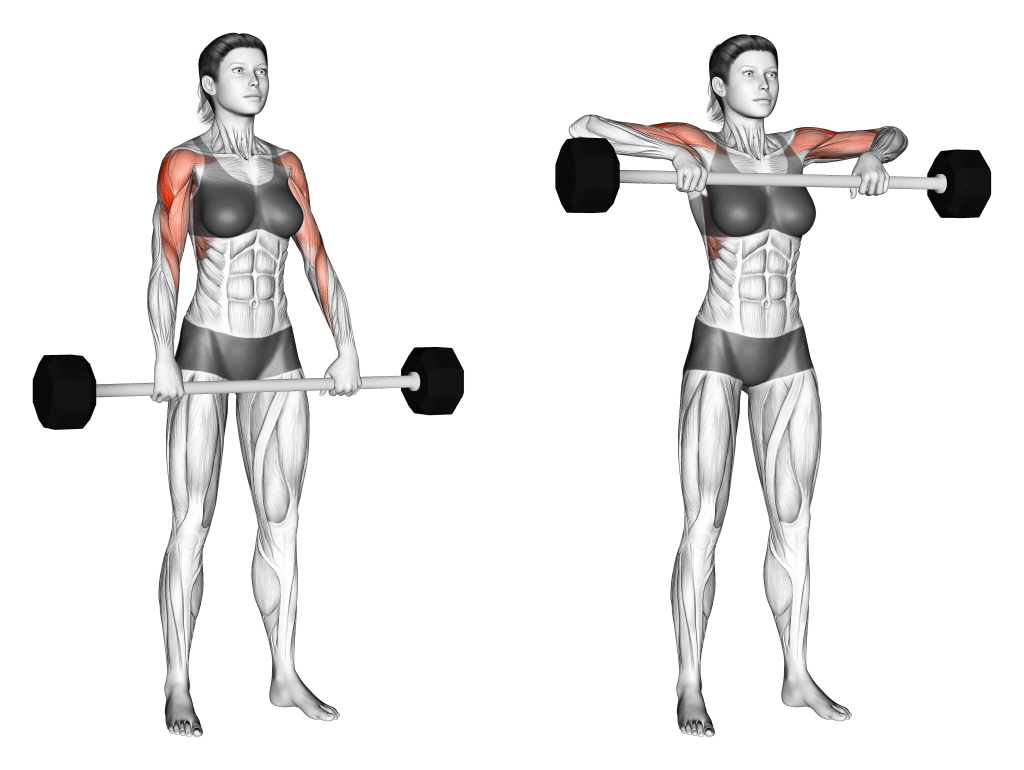
Upright Barbell Rows are fantastic for engaging the lateral deltoid muscle. This barbell exercise primarily engages the middle delts and traps, making it invaluable for building beefy shoulders.
It’s an easy movement, and you can perform variations with dumbbells, kettlebells, resistance bands, and cable machines if necessary. Proper technique is critical to avoid pain in the shoulder joint or injury.
- Hold a barbell in front of you with a grip slightly narrower than shoulder-width.
- Pull the barbell up towards your chin, keeping it close to your body.
- Lower the barbell down and repeat.
4. Machine Shoulder Raise
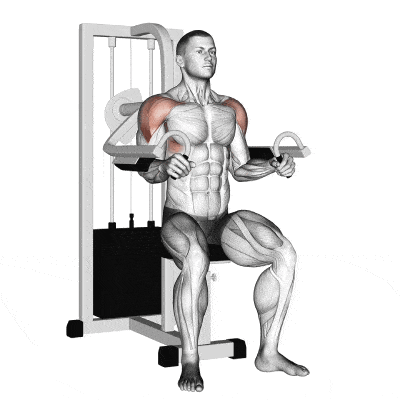
You’re probably thinking, “Why would you perform the Machine Lateral Raise instead of the dumbbell or cable variation?”
The Machine Lateral Raise has a guided motion ensuring precise isolation of the lateral deltoids, which can be challenging with other raise variations. By using the machine, you minimize the involvement of different muscle groups, maximizing the tension on the lateral deltoids.
Incorporating the machine variation into your training schedule can help you engage the middle delt, enhancing outer shoulder size and strength.
- Adjust the machine’s seat and handles to fit you comfortably.
- Place your forearms against the pads and press upward.
- Raise the handles by extending your arms upward.
- Lower the handles and repeat.
5. Behind the Neck Press
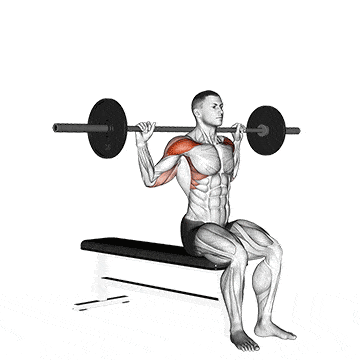
The Behind the Neck Press is an advanced shoulder exercise that targets the deltoids, with a particular focus on the lateral and posterior deltoids. This variation of the overhead press is performed by pressing a barbell from the back of the neck overhead, requiring good shoulder mobility and flexibility.
This exercise can be challenging and is best performed with caution to avoid strain or injury to the shoulder joints. Variations can include using a Smith machine for stability or dumbbells for a slightly different muscle engagement. The key to safely executing the Behind the Neck Press lies in using a controlled motion and ensuring that your shoulder mobility is adequate to perform the exercise without discomfort.
To do the Behind the Neck Press:
- Sit or stand with a barbell positioned at the back of your neck, holding it with a grip wider than shoulder-width.
- Press the barbell up and overhead to full arm extension, keeping the back straight and core engaged.
- Lower the barbell back to the starting position behind the neck slowly and with control.
- Repeat for the desired number of repetitions, focusing on maintaining good form throughout the movement.
Rear Deltoid Exercises
The rear, or posterior deltoid, doesn’t get enough love. It is involved with the extension and external rotation of the arm. You use it in activities like pulling the arm back to throw a frisbee or punch.
Rear deltoid training is critical, as it helps with shoulder stabilization and posture, preventing your shoulders from rolling forward. Here are a few movements to think about during your next shoulder day.
1. Rear Delt Raise
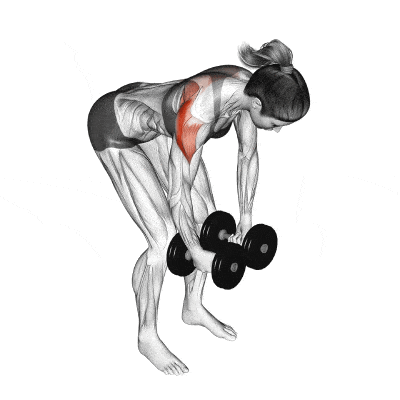
Rear delt isolation work is often neglected, but it is critical for well-developed shoulders. Fortunately, that’s where movements like the Rear Dumbbell Delt Raise come in handy. This exercise will engage the posterior delts alongside the upper back muscles.
You can also perform single-handed variations, swapping between arms to engage one side at a tie. Either way, this dumbbell exercise will help you develop broad shoulders and a more prominent upper back.
- Hold dumbbells in front of your thighs, palms facing each other.
- Lift the dumbbells to the sides while keeping your arms slightly bent.
- Raise until your arms are parallel to the ground.
- Lower the dumbbells back down slowly and repeat.
2. Arnold Press
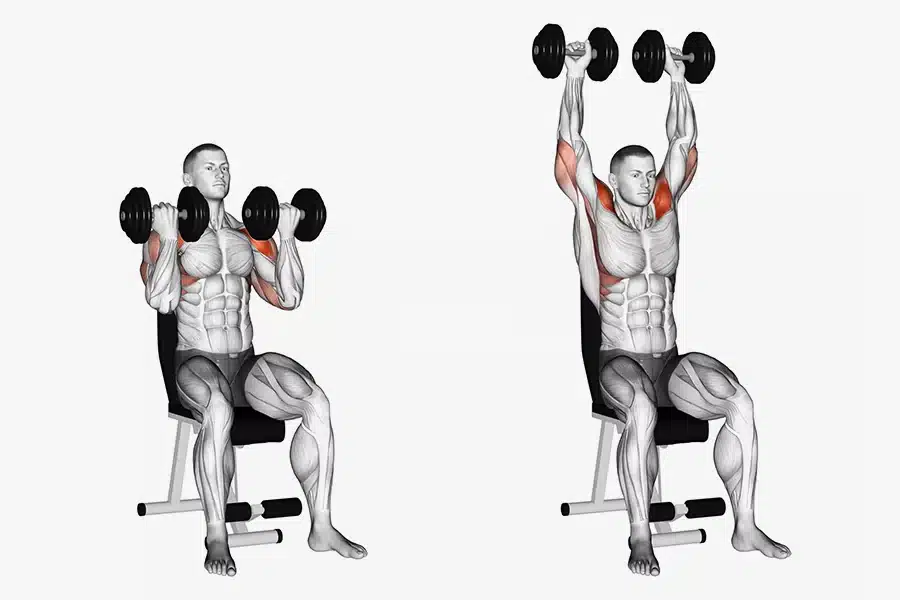
Another overhead shoulder workout is the Arnold Press, developed by Arnold Schwarzenegger himself. This movement will provide you with absolute deltoid dominance, as it targets all three deltoid heads. The Arnold Press requires you to rotate your palms as you press the weight, which targets the posterior deltoid.
It can be performed from a seated or standing position, depending on if you want more core activation. Because effective rear delt movements can be hard to come by, we recommend including the Arnold Press into your shoulder training regimen.
- Begin with dumbbells around shoulder height, palms facing your body.
- Raise the weights overhead while turning your palms to face the wall.
- Reverse the motion on the way down, turning your palms back toward your body.
3. Face Pulls
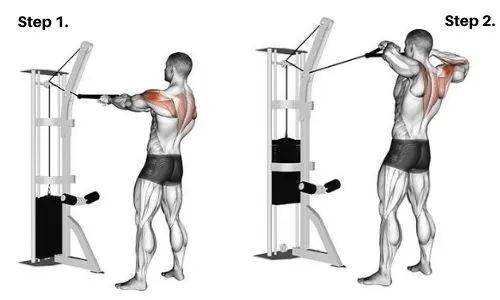
If you’ve seen someone in your gym performing Face Pulls, you might have thought they looked a bit funny, but this exercise is fantastic for engaging the posterior deltoid muscles.
It will help you build boulder shoulders and a more considerable upper body, as it targets the rear delts, rhomboids, and traps in one motion. This exercise also helps in improving posture and reducing the risk of shoulder imbalances, making it a valuable addition to any shoulder training regimen.
- Attach a rope handle to a high pulley cable.
- Hold the rope with palms facing each other.
- Pull the cord towards your face, squeezing your rear deltoids.
- Slowly release the rope and repeat.
4. Single-Arm Dumbbell Row
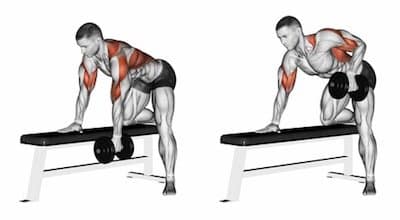
Although it’s mostly programmed as a back exercise, the Single-Arm Dumbbell Row is a fantastic rear delt movement. As a unilateral exercise, it will help with muscle discrepancies, stability, coordination, and strength.
It’s a compound exercise, as you engage the lats, trapezius, rhomboids, and core as well. The single-arm dumbbell row is versatile, allowing any level of training experience to easily adjust the weight and focus on form.
- Place one knee and hand on a bench, opposite foot on the ground.
- Hold a dumbbell in your free hand, and let it hang toward the ground.
- Pull the dumbbell towards your hip, squeezing your back muscles.
- Lower the dumbbell to the original stance and repeat on the other side.
5. Reverse Dumbbell Flyes
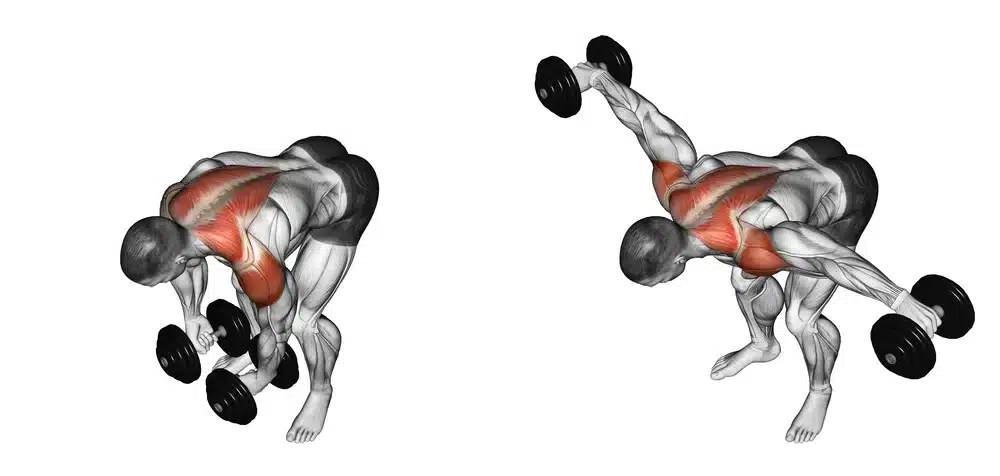
Reverse Dumbbell Flyes are essential for targeting the often overlooked posterior deltoid muscles, contributing to a comprehensive shoulder development. This exercise effectively isolates the rear delts, while also engaging the rhomboids and traps in the upper back.
Performing Reverse Dumbbell Flyes can enhance muscle balance and posture, crucial for a well-rounded physique. Variants of the exercise can include using a bench to lie face down for stability or standing bent over to incorporate a greater range of motion. Mastery of form and controlled movements are paramount to maximize muscle engagement and minimize the risk of injury.
To do Reverse Dumbbell Flyes:
- Stand with your feet shoulder-width apart, knees slightly bent, and lean forward from the waist, maintaining a flat back.
- Hold dumbbells with palms facing each other and arms slightly bent at the elbows.
- With a smooth motion, lift the dumbbells outward and up to shoulder level, squeezing your shoulder blades together.
- Lower the dumbbells back to the starting position with control.
- Repeat for the desired number of repetitions, focusing on the movement of the rear deltoids throughout the exercise.
Example of a Shoulder Workout
It’s easy to put together your own effective shoulder exercise routine. Don’t forget to warm up first—the shoulder is a complex joint and can get injured easily, so spending 15 minutes or so on warming up is well worth it.
Warm-Up
Nothing too strenuous, but a proper warm-up is essential. Opt for 5 to 10 minutes of light cardio to get the blood flow going. If you’ve got a resistance band or a cable machine, you can do some external and internal rotation exercises to get the rotator cuff working, but keep them light.
Finish your warm-up with some arm circles (forward and backward), shoulder shrugs, and front and lateral raises without the weights. Between 10 and 15 reps of each should be good.
Workout
Choose 4 to 5 shoulder exercises to do in one session. We’ve focused more on the lateral and rear delts, with less of a focus on the front delts, as they get a good bit of activation on chest days and back days.
Here’s an example of a well-rounded shoulder workout. You can chop and change exercises on shoulder day if you want to, but make sure you’re hitting all those delts.
- Overhead press (front & lateral delts): 3 sets of 4 to 6 reps (men) or 8 to 10 reps (women).
- Barbell delt row (rear delts): 3 sets of 4 to 6 reps (men) or 8 to 10 reps (women).
- Lateral raise (lateral delts): 3 sets of 4 to 6 reps per arm (men) or 8 to 10 reps per arm (women).
- Reverse fly (rear delts: 3 sets of 4 to 6 reps per arm (men) or 8 to 10 reps per arm (women).
Rest between sets as needed. A minute to two minutes is a good rest time to allow your muscles enough time to lift effectively in the next set.
Cool-Down
You can do some light cardio to help your muscles loosen up and flush out lactic acid. We also recommend 5 minutes or so of light stretching, especially of the shoulders, upper back, and neck.
Why Train the Shoulders?
There are several advantages to training the shoulders, like more functional strength, better posture, and a broader upper body. Here are some benefits to keep in mind:
- Functional Strength and Stability: Well-developed shoulder muscles provide the foundation for various daily activities, from lifting groceries to carrying bags. Strengthening your shoulders enhances overall upper body functionality and stability.
- Improved Posture: Strong shoulder muscles help maintain proper posture by supporting the alignment of your spine and upper body. This can prevent slouching and reduce the risk of developing postural issues over time.
- Enhanced Aesthetics: Well-defined shoulders contribute to a balanced and visually appealing physique. Developed deltoid muscles create the illusion of a narrower waist and broader shoulders, which is often associated with a strong and healthy appearance.
- Injury Prevention: Strengthening the muscles around the shoulder joint can reduce the risk of injuries, such as strains and rotator cuff issues. A balanced shoulder workout helps maintain joint integrity and minimizes the potential for overuse injuries.
- Functional Range of Motion: Training your shoulders through various exercises helps improve flexibility and range of motion. This is essential for maintaining your ability to perform everyday tasks and preventing stiffness that can come with a sedentary lifestyle.
Start With a Shoulder Warm-Up
Many of these exercises may sound like basic movements that you can immediately jump into, but this would be a detriment to your performance.
See, the shoulder joint is one of the most complex systems in the body. Several tendons, muscles, bones, and ligaments combine together to provide mobility.
But without a proper warm-up, you’re dramatically increasing your risk of a potential shoulder injury or strain. Here’s what to do before performing your shoulder routine.
Do Some Light Cardio
You might think, “Cardio? I’m training my shoulders, not my legs!” But low-intensity cardio is critical for a great training session.
Jogging, stair-climbers, jump rope, and other exercises raise your body temperature and heart rate. This allows nutrient-rich, oxygenated blood to flow throughout your body, improving exercise performance.
It’s best to increase your heart rate to 55–65% of its maximum capacity for 5–10 minutes. Don’t go overboard; just get a light sweat going.
Dynamic Stretches
As mentioned earlier, the shoulder joint is incredibly complex, with a larger range of motion compared to other joints in the body. This makes it prone to injury, so stretching and moving the muscle through different ranges of motion is a must.
There are several options you can incorporate into your warm-up, including some of the following dynamic stretches:
- YTWs
- Cross-body shoulder stretch
- Alternating chest hugs
- Straight arm circles
- Shoulder shrugs
Performing a few sets of each of these movements will prepare the shoulder muscles for a larger range of motion, allowing you to get a deeper stretch in your deltoid muscles.
Pyramid Sets
Don’t start lifting weights just yet—you need to do a few pyramid sets to prime your muscle for heavy weights. Performing a few sets with lighter loads and increasing your working set will reduce your chances of injury. Here’s a quick example:
- Set 1: 10 x 50% working weight.
- Set 2: 8 x 60% working weight.
- Set 3: 5 x 80% working weight.
Once you’re done with these sets, you can execute the movement with your desired weight and rep range. Be sure to use lighter, manageable weights so you don’t burn out before you start your working set.
What Does Science Tell Us About Deltoid Muscles
- Muscle Activation During Selected Strength Exercises: Studies on muscle activation during various shoulder exercises, such as lateral raises and upright rows, highlight the importance of the deltoid muscle in performing these movements. Exercises involving shoulder abduction and external rotation tend to elicit significant deltoid activation, supporting their use in strengthening programs (Andersen et al., 2008).
- Dynamic Glenohumeral Stability Provided by Deltoid Muscle: The deltoid muscle’s contribution to shoulder stability, especially in the context of reverse shoulder arthroplasty, underscores its importance in shoulder mechanics. Strengthening the deltoid, particularly its anterior and middle segments, is crucial for enhancing shoulder function and stability (Lee & An, 2002).
- Electromyographic Activity in Various Weight-Bearing Positions: Research has also explored how different weight-bearing positions, such as prone-on-elbow, quadruped, and standing, affect deltoid muscle activation during shoulder flexion exercises. Findings suggest that certain positions can enhance deltoid strengthening by increasing muscle activation levels (Ju & Yoo, 2015).
Frequently Asked Questions (FAQ)
Are 3 Shoulder Exercises Enough?
Three shoulder exercises can provide a solid training session 1–2 times per week. You might perform the barbell overhead press, Arnold press, and an isolation exercise, like a lateral raise. This will target all three deltoid heads, helping you develop strength, stability, and shoulder size.
What Are the Most Effective Shoulder Exercises?
Some of the most effective shoulder exercises include the barbell overhead press, Arnold press, push press, seated dumbbell press, and rear dumbbell raises. These movements engage all three deltoid heads and can be easily incorporated into your routine.
What Is the King of All Shoulder Exercises?
The king of all shoulder exercises is the standing barbell overhead press. It is a foundational movement that engages all three deltoid heads. You can load heavy weights to develop strength, mass, endurance, and size.
References
- Lars L Andersen, Michael Kjær, Christoffer H Andersen, Peter B Hansen, Mette K Zebis, Klaus Hansen, Gisela Sjøgaard, Muscle Activation During Selected Strength Exercises in Women With Chronic Neck Muscle Pain, Physical Therapy, Volume 88, Issue 6, 1 June 2008, Pages 703–711, https://doi.org/10.2522/ptj.20070304
- Lee, Seok-Beom MD; An, Kai-Nan PhD. Dynamic Glenohumeral Stability Provided by Three Heads of the Deltoid Muscle. Clinical Orthopaedics and Related Research 400():p 40-47, July 2002.
- Sung-kwang Ju, Won-gyu Yoo, Electromyography activity of the deltoid muscle of the weight-bearing side during shoulder flexion in various weight-bearing positions, Journal of Physical Therapy Science, 2015, Volume 27, Issue 10, Pages 3285-3286, Released on J-STAGE October 30, 2015, Online ISSN 2187-5626, Print ISSN 0915-5287, https://doi.org/10.1589/jpts.27.3285

